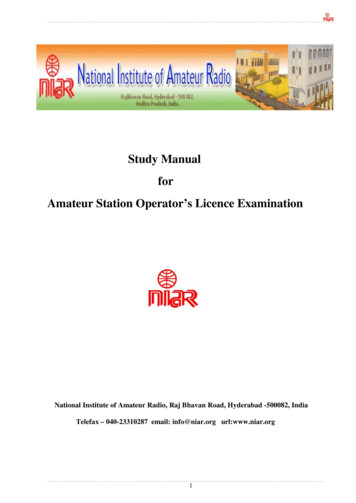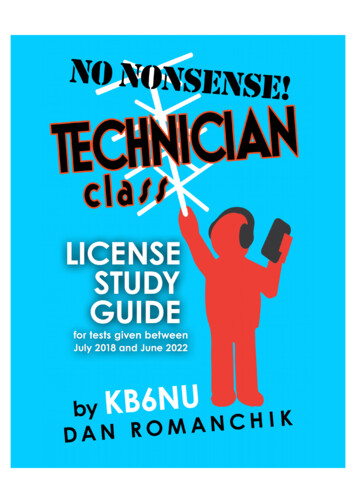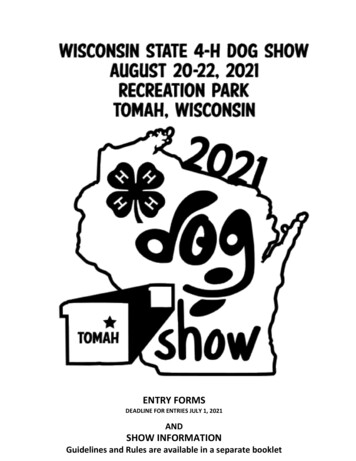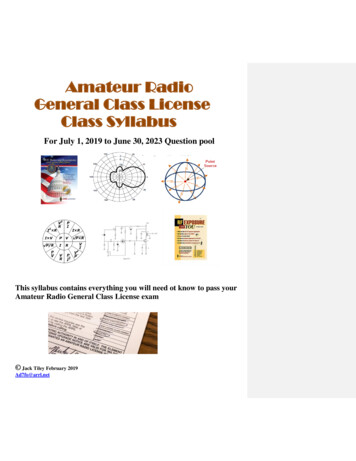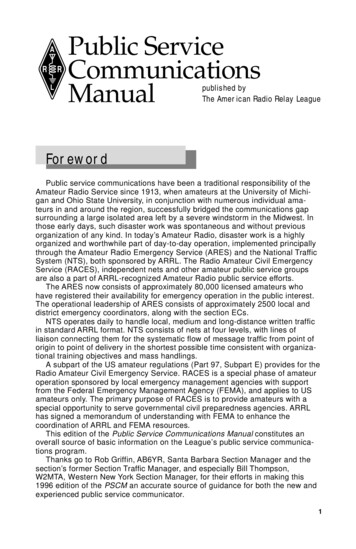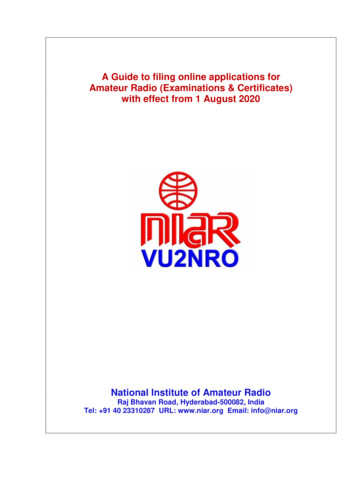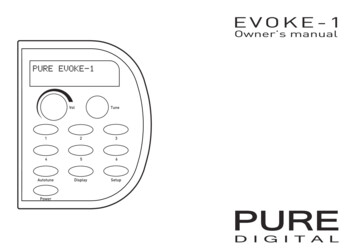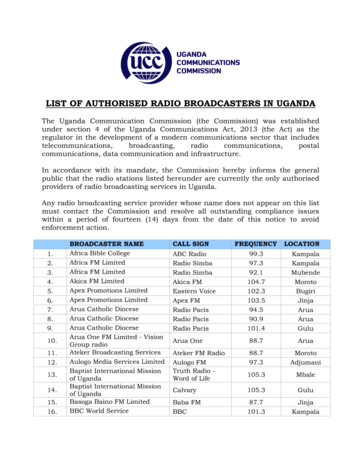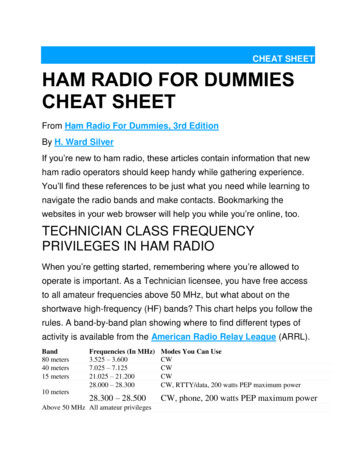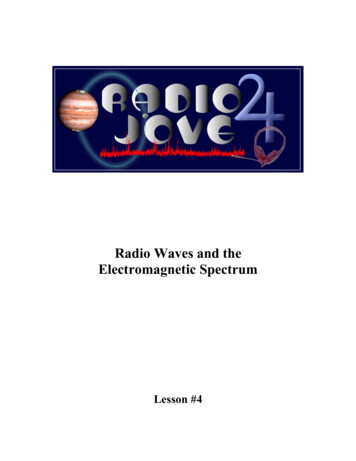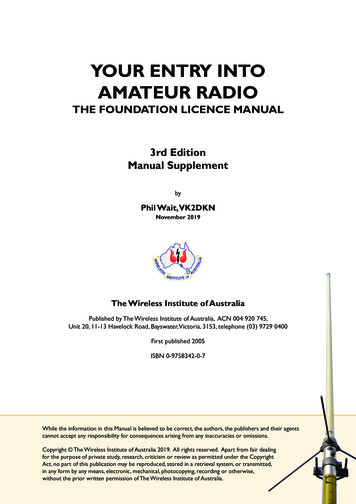
Transcription
YOUR ENTRY INTOAMATEUR RADIOTHE FOUNDATION LICENCE MANUAL3rd EditionManual SupplementbyPhil Wait,VK2DKNNovember 2019The Wireless Institute of AustraliaPublished by The Wireless Institute of Australia, ACN 004 920 745,Unit 20, 11-13 Havelock Road, Bayswater,Victoria, 3153, telephone (03) 9729 0400First published 2005ISBN 0-9758342-0-7While the information in this Manual is believed to be correct, the authors, the publishers and their agentscannot accept any responsibility for consequences arising from any inaccuracies or omissions.Copyright The Wireless Institute of Australia 2019. All rights reserved. Apart from fair dealingfor the purpose of private study, research, criticism or review as permitted under the CopyrightAct, no part of this publication may be reproduced, stored in a retrieval system, or transmitted,in any form by any means, electronic, mechanical, photocopying, recording or otherwise,without the prior written permission of The Wireless Institute of Australia.
changesOn the 12th September 2019 the Commonwealth of Australiaamended the Conditions for the Amateur Radio Foundation Licence.The amendments increase the flexibility, utility, and relevance of theFoundation licence by removing unnecessary restrictions, while balancingthe risk of interference to other radio spectrum users.The following is a summary of the changes to the current Foundation Licence Manual (rev 3).What has changed ?Page 58 – The Foundation Licence:A Foundation License is now subject to the conditions in; the Radiocommunications LicenceConditions (Amateur Licence) 2015 Compilation 2 of 2019. The Licence ConditionsDetermination No.1 of 1997 is no longer in force.Page 58 – Restrictions on a Foundation Station:Point 1.Foundation Licensees may authorise another person to operate their station.If the person is unlicensed the Foundation licensee must be in attendance at alltimes.Point 3.Foundation licensees may operate an amateur station over the internet inautomatic mode or computer-controlled mode, and may operate a station that isdirectly connected to a public telecommunications network.Page 59 – Type of Equipment:Foundation licensees may transmit using equipment constructed by themselves or others.Page 59 – Permitted Frequencies and Modes:Previously, by only permitting transmission of analogue voice and Morse code, Foundationlicensees were effectively restricted to narrow bandwidth modes of less than 8kHz.Foundation licensees can now transmit any mode (such as digital data, digital voice andimage modes i.e. television) with maximum occupied bandwidths specified in the table below.The effective restrictions on emission modes have now been removed. Naturally, the entiretransmission must be wholly within the amateur frequency band.The frequency band 7.100 – 7.300 MHz is a primary short-wave broadcast band, and is used byamateurs on a secondary basis. Transmissions above 8kHz bandwidth are not permitted in thisband. All modes less than 8kHz bandwidth are permitted.Digital Modes:Foundation licensees are now permitted to transmit data or digitised speech and can use digitalrepeater networks.
changes cont .Power of Wideband Transmissions:In a wideband transmission the transmitter power is spread over a wide range of frequencies.Power is then described as a spectral power density, and it is kept low to avoid interference toother stations using that frequency range. In fact, other stations are likely to be unaware of awideband transmission sharing the same frequency range.The maximum permitted spectral power density for Foundation Licensees using wide bandwidthtransmissions is 1 Watt per 100 KHz. That means 1 Watt of power can be evenly spread out over100kHz, or two watts could be spread out over 200kHz, or 0.5 Watts over 50kHz etc.The maximum transmitted bandwidth, over which power must then be measured as a spectraldensity, is shown in the table below.Frequency bandPermitted emission modes13.500 MHz–3.700 MHz7.000 MHz–7.100 MHz21.000 MHz–21.450 MHzAny emission mode.Where the necessary bandwidth exceeds8 kHz, the maximum power spectral densityfrom the transmitter must not exceed1 watt per 100 kHz.228.000 MHz–29.700 MHzAny emission mode.Where the necessary bandwidth exceeds16 kHz, the maximum power spectraldensity from the transmitter must notexceed 1 watt per 100 kHz.37.100 MHz–7.300 MHzAny emission mode with a necessarybandwidth no greater than 8 kHz.4Any emission mode.144.000 MHz–148.000 MHz430.000 MHz–450.000 MHz
4changes cont .Changes to the Foundation Syllabus & ExaminationsAmateur Radio syllabuses are produced by the ACMA in association with the WIA and others. Atthe time of writing the ACMA had not released changes to the Foundation Licence Syllabus, butsome possibilities are listed below together with the outdated clauses in the current syllabus. Thisinformation may change and should be taken as a guide only1.Nature of Amateur Radio - No change:2.Licence Conditions – Changes:2.1The Licence Conditions Determination No.1 of 1997 is no longer in force.A Foundation Licensee is now subject to the conditions in; theRadiocommunications Licence Conditions (Amateur Licence) 2015 Compilation 2of 2019.2.12 Foundation licensees may transmit using equipment constructed by themselvesor others.2.16 Foundation Licensees may authorise another person to operate their station.If the person is unlicensed the Foundation licensee must be in attendance at alltimes.2.17This clause no longer applies. A Foundation licensee may now operate a stationin computer controlled mode.2.18 This clause no longer applies. A Foundation licensee may operate an amateurstation over the internet in automatic mode or computer-controlled mode, and mayoperate a station that is directly connected to a public telecommunicationsnetwork.3.Technical Basics – Changes:This section will probably be expanded to reflect the minimum level of knowledge required fordigital techniques. Some possibilities are: Recall that analogue signals are constantly changing in amplitude, frequencyor both. Recall that digital signals are a stream of finite values at a specific sampling rate. Recall that a high-speed digital signal uses greater bandwidth. Recall that a low-speed digital signal uses less bandwidth. Recall that digital signals can be processed by a computing device with suitablesoftware. Recall that an Analogue to Digital Convertor (ADC) is a device used to convert ananalogue signal to a digital signal.
5changes cont .4.Transmitters and Receivers – Changes:This section will probably be expanded to reflect the minimum level of knowledge required fordigital techniques. Some possibilities are: Recall that an SDR receiver takes in all analogue electrical signals from the antennaand converts them to digital format. The signals are tuned (filtered) using softwarein a digital signal processor (special type of computer). Recall that there are a number of different digital voice (DV) and digital data (DD)modes and that different systems may not be compatible.5.Transmission Lines and Antennas – No change6.Propagation – No change7.Interference – No change8.Operating Practices and Procedures – No change9.Safety – No changeWhat About Frequencies and Power ?Changes have not been made to the Foundation Licence Conditions with respect to permittedfrequency bands and transmitted power. The ACMA have advised the WIA that these outstandingitems will be reviewed within the ACMA’s current 5-year work plan.
the risk of interference to other radio spectrum users. The following is a summary of the changes to the current Foundation Licence Manual (rev 3). What has changed ? Page 58 – The Foundation Licence: A Foundation License is now subject to the conditions in; the Radiocommunications Licence Conditions (Amat
